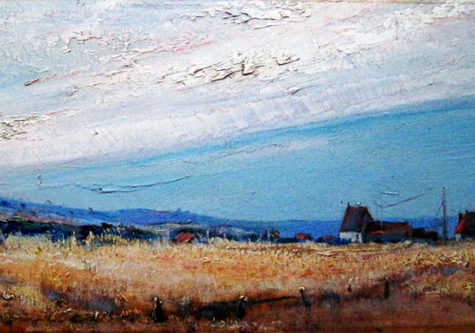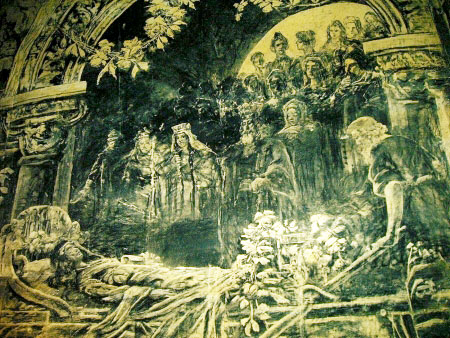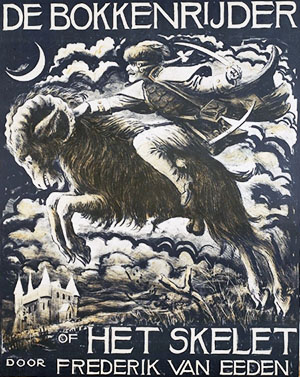
Limburg is a land of rolling hills and meandering streams, chock-full of old towns and villages. It is a land of castles, abandoned mines, Roman, Prussian and French remnants and ruins, all kept together by modern Dutch, German and Belgian buildings. It’s a peculiar hodge podge recipe of a whole bunch of ingredients I happen to love.
To me it is a shame then, that Limburg’s wealth of folklore is unknown to the world at large.

In an attempt to correct that, I’ve rewritten two tales from “Limburgsche legenden, sagen, sprookjes, en volksverhalen”. These stories along with over one hundred and fifty others were compiled by the Limburgish pastor H Welters in an effort to preserve the local legends, fables and sagas in the face of Dutch integration efforts at the time.
The tales found below are not direct translations of the originals, but close interpretations of them wherein the wordplay and pace differs slightly. That said, the cores of these stories have been left unaltered and I have opted to not change their plots or the viewpoints from which they are told in any way.
I hope you enjoy them.

Riddert the Knight
In a castle near the town of Maaseik, a man by the name of Riddert lived. He was a knight as rich as the river Meuse was deep, and no one could explain the how or why. To the wise folk there was but one possible explanation to such vast, inexplicable wealth: Riddert had promised his soul to Satan.
After seven merry years of enjoying his bounty, Riddert invited all of his family, friends and acquaintances to a grand meal at his home, with no expense spared. Food from far and wide was served and the finest of wines were poured. Such was Riddert’s generosity that his guests felt obliged to ask for the occassion. It was then that Riddert with heavy heart admitted that the many rumors around his wealth were true, and that on that very same day his soul was to be given to the devil at long last. His guests begged him to forsake his promise, but Riddert would not hear it. On a knight’s oath, a promise is a promise.
When it had become clear to the guests that their beloved host refused to budge, they begged one small favour from him. Riddert was asked to bring a goblet to the shrine of saint Gertrude, she who blessed the pilgrims to Santiago, she who received the farewell toast. Riddert agreed to this final sign of departure. He made his way to the shrine, placed the item at its base and performed a quick prayer, after which he called his steed and left Maaseik.
Riddert rode a short while along the river Meuse which meandered ever careless forth. Past the hamlet of Heppeneert he found the devil with contract in hand, waiting under the wide green branches of a Linden. Riddert dismounted his trusty beast, bid it farewell and marched off to his doom.
To the knight’s surprise no fire and brimstone rained down upon him. Instead he saw the devil’s smile turn to a frown, who began to moan: ‘Not fair, not fair at all. I can’t do anything to you with that blessed virgin behind your back!’
The knight turned around to meet the holy Gertrude. He fell to his knees, tears streaming from his face. Riddert with heavy regret for his unholy deed promised the saint he would nevermore live in sin. From there on he vowed to spend his life in service to the lord.
Knowing he was beat, the devil ripped the contract to pieces. The knight would come to live a long and virtous life thereafter, and on a day now long past he passed peacefully by the grace of god. His castle would pass hands many times after his departure, eventually being turned into a tavern so that all folk in the region could enjoy its splendor.
Commentary
The basic plot of a person selling their soul to the devil only for their goodness to earn them a second chance in life is a fairly common one in folklore, whatever form the soul and devil may take per setting.
What made this story interesting to me, is how it is construed in a distinctly Limburgish context, thereby infusing it with character. It does so for instance by using the Meuse to symbolize the vastness of Riddert’s wealth. It uses the Linden, one of the most hallowed trees in our germanic heritage, to anchor the devil in the story to the lingering pagan past of the region. Saint Gertrude’s shrine was an important node for local travels on the route to Santiago, and like any other place in Western Europe steeped in Catholic tradition, chivalry and the inherent virtue ascribed to knights still lives in folk memory. This provides an additional layer of sinfulness to the knight’s unexplained reasons for striking a deal with the devil. I have emphasized these aspects in my rendition, but the underlying tones were all present in the original.
In this sense, the story provides a lense into the importance of worldbuilding to even the shortest of stories. Without context, this story would be just that, a simple story, but by anchoring it into the folk imagination of its setting, the story gains soul.
The Fire Man of Arcen to Velden
From Arcen to Velden travels at twelve in the night
A man glowing of fire, a will o’ wisp sight.
And when he so roams, folk invariably say,
that the Fire Man wails: “Where shall my border stone lay?”
Let him pass in silence or you will find on your path,
The wrathful fate that many man met.
For once bid a lad: “Just lay back that slab,
From where you had it nabbed!
As quick as lightning, the Fire Man charged
First small as a spark growing wildfire large
To the lad’s luck he had three crosses made,
Had he not done so, solely cinder would stay
_________________________________
Such fairy tales folk swiftly came to know,
But beyond mere stories it had lessons to bestow
Firstly: No boundary mark was to be moved
For you would regret it when justice was proved
Secondly: Let lying and fibbing be in vain
Thirdly: Call on God when in fear or in pain.
Commentary
Back in the day, the boundaries of fields and farms were marked by stones. Moving these stones was a way of stealing land from your neighbour. As the story above attests, committing such theft was not a smart idea for those concerned with their soul, for it would doom a man to roam the world as a blazing spirit of discontent. Other tales of the fire men tell of other unfortunates unlucky enough to catch the attention of them. These folk are either chased until the fire man catches them, or manage to escape them by reaching their homes. Indoors the fire man can’t catch a person and will instead burn its black hand into their front door as a warning for the next time they’ll meet.
The Giant Hole of Echt
A long time ago, when giants walked the land, their king was set to marry. As was custom, he and his soon-to-be queen were to dig their own home before they would be wedded.
The couple dug from morning to evening each day for the span of a decade, during which they said not a word to each other. One bright morning a bird flew by.
‘Look there’, the almost queen said: ‘a crow just flew by!’
‘That was a starling dear, not a crow,’ the giant king replied, ‘let’s continue digging.’
The couple then dug in silence for a decade more when the giantess once more spoke: ‘the bird I saw was definitely a crow.’
The giant king promptly walked away from his unfinished home, ‘You’re nagging me to death, the wedding is off!’
And so the king of giants never married and his hole has laid barren ever since. Finding the giantesses to be blabbermouths as well, all other giants in Limburg followed their king’s example. Thus the race of giants became extinct.
Nowadays the hole in question is said to still lie somewhere in the farmfields and woodlands between Echt, Posterholt and Montfort. Its current size would have you wonder whether or not the giant couple would still be digging today had they not separated.
Commentary
Limburg, for all its bountiful history, beautiful cities and many tales, has always been a land of farmers and miners above all else. Therefore I decided to include this tale partly because it made me chuckle, and partly because it reflects the mentality of this land. The Limburgish people are on average salt of the earth, and nothing demonstrates that better to me than the casually dry humor of this fable. They may have once ruled Limburg, like many humans would rule here thereafter, but not even giants loom too large to be mocked.
To Conclude
 Only three stories down and I haven’t touched the surface. From chivalric legends, to saintly tales and various fables of all kinds, Welters and his contemporaries have more than enough stories left to tell. Why didn’t I talk about the orcish earth men who live under the ground and bless the homes of benefactors? What about the pale women who haunt the mist? The many saintly tales? Or what about the dastardly buckriders who rob the unfortunate and then dash into the skies on their flying mounts?
Only three stories down and I haven’t touched the surface. From chivalric legends, to saintly tales and various fables of all kinds, Welters and his contemporaries have more than enough stories left to tell. Why didn’t I talk about the orcish earth men who live under the ground and bless the homes of benefactors? What about the pale women who haunt the mist? The many saintly tales? Or what about the dastardly buckriders who rob the unfortunate and then dash into the skies on their flying mounts?
Those will have to be told another day. If you would like to keep up with my exploits you can follow me on instagram or on writtenfood to view my art, read more stuff and receive updates on further translations in the future. I hope you’ve enjoyed these stories of my homeland and I would love to read you reactions.


I think preserving folklore of a region is such an important task, so awesome that you’ve taken it upon yourself to invest in these tales. I hadn’t heard any of these, but as others pointed out, they bear themes often found in fairytales. Will you be continuing this particular series of Limburg tales?
Thank you very much Jen, it means a lot to me that folk from beyond my home are able to enjoy regional tales. I plan to continue my translations, with hopes of translating H Welters full work somewhere in the future. If nothing gets in the way, I should have a follow-up to this article later in the year.
Dear Stilton Swindler,
I really think you might enjoy reading Edward Trencom’s Nose: A Novel of History, Dark Intrigue, and Cheese by Giles Minton. Check your local library!
Sincerely,
Swindler Sidekick
Dear Provolone Protégé,
I haven’t come across this book before, but I’m giving it 1 unlicensed Michelin star based on the title alone. Thank you very much for the recommendation.
Sincerely,
The Paneer poet
On a related note, have you played the Witcher 3 expansion “Heart of Stone?” It presents a very cool reinterpretation of the “sold soul to the devil” motif.
I have yet to play the first two games in the series. I should really make time for that at some point, I’ve heard great things about the series.
These are lovely stories. They evoke memories of the Germanic fairy tales that I studied during my youth.
The tale of Riddert the Knight is similar to other stories that I encountered abroad. Although in those tales no saint intervenes, and there is no happy ending.
Stories of men bargaining their souls appear to be nearly universal, transcending cultures. Why is that?
Thank you Greybeard. You pose an interesting question that might merit a thread of its own.
If I were to guess, I would say that cultures from all over turn toward these stories of men selling their souls to a devil figure, simply because that transaction serves as an effective allegory for living in sin. Sin and the negative effects of them are hard to convey, but nearly everyone is able to imagine the concepts of a soul and a devil figure, therefore those are the representations that become most widely adopted.
Those are just my two cents though, I wouldn’t be surprised to hear a number of other possible explanations.
I think that’s a reasonable explanation. Such stories take the abstract concepts of sin and evil, and makes them more concrete and relatable.
Of course, I would not entirely rule out the possibility of there being actual cases of individuals literally pledging their souls to sinister supernatural entities. As a person of faith, I accept that as a real – albeit unlikely – possibility.